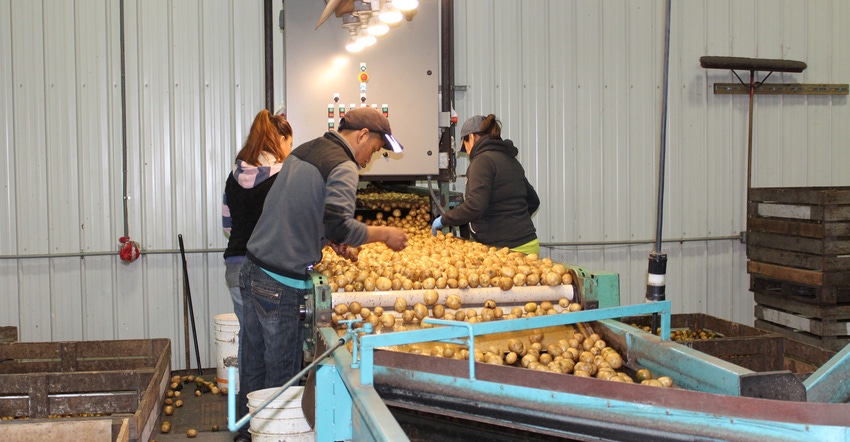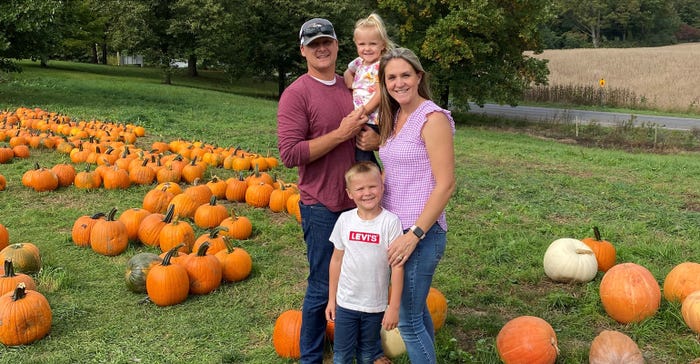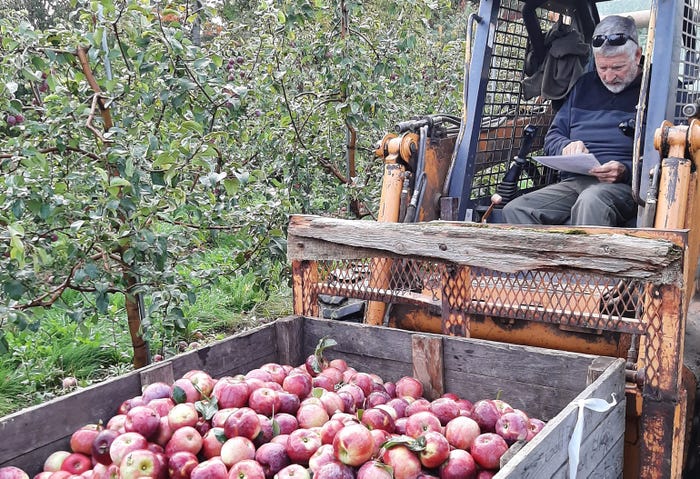
How was this past year on the farm, and what plans do you have for 2022?
It’s time to start taking stock and planning ahead, and there’s a lot to think about as we turn the calendar to a new year.
We surveyed several farmers in the region and asked them four questions:
What things went well for you in 2021?
What are some new things that you plan on doing in 2022?
How are the current issues around fertilizer availability and pricing affecting your decision-making?
As 2022 approaches, what is your outlook? Are you pessimistic, optimistic or somewhere in between?
Here’s what we found:
Pennsylvania perspective
David Wenk, who grows 335 acres of tree fruits in Aspers, Pa., says “everything went better” in 2021. “Retail farmers markets up approximately 25%,” he says. “All crops grown were very good. We had [barely] sufficient labor. All our commodity prices were good until the peach market was saturated.”
He hasn’t had time to think about new things he’ll try in 2022, but he’s keeping his eye on fertilizer prices. His plan was good in 2021, so he’s planning on trying much of the same in 2022, at least for now.
“I am very optimistic,” Wenk says. “Apple prices [our main commodity] have been restored to regular, non-trade war prices. That is a 20% increase or more. If we can get over the COVID obstructions, we can thrive. I am pessimistic about political divisions.”
David Reinecker, who raises 260 acres of crops and finishes 1,500 pigs and 100 beef cattle annually in York Springs, Pa., says “Pork prices have ended up being unexpectedly strong, even with feed prices being high. The stronger pork prices have been a blessing. On the grain side, our corn and soybean yields have been near all-time highs.”
Still, he’s getting ready for a more challenging 2022. “With fertilizer prices looking to be extremely high, we will be testing most all of our fields going into corn and bean in 2022,” Reinecker says. “Hopefully, we will be able to use some of our reserves in the soils and thus cut back on the need for commercial fertilizers. We will also look to do a better job in using our beef and pig manure on soils that may show a greater response.”
He’s optimistic for next year. “Beef prices look to trend higher, and hopefully, pork prices will remain strong,” Reinecker says.
Reid Hoover, who milks 370 cows and farms 120 acres in Lebanon, Pa., says Mother Nature was kind to him in 2021.
“Weather was good for crops and yields,” he says. “Spring forages yielded well and were of good quality. Corn silage yields were very good. The quality is still being determined as we see how the cows respond to it. Our cover crop is in the ground and getting a good start growing. Our family and employees managed to stay healthy.”
Hoover says that he’s planning on starting the farm’s transition plan next year and will continue some new things he tried last spring and summer.
“We are working to get the most value out of our manure,” he says. “We used drag-lining and incorporated the manure to retain more of the nutrients and had less compaction of the soil. We pre-purchased some of our fertilizers to hedge against anticipated price increases.”
Hoover is trying to be optimistic about dairy, but it’s a wait-and-see game. “We are hopeful that some of the signs are pointing to improved milk prices in 2022,” he says. “Cattle prices seem to be rebounding, which is encouraging. Our forage inventory is at a good level for the coming year.”
Russ McLucas of McConnellsburg, Pa., who grows 180 acres of corn, 80 acres of soybeans, 220 acres of wheat and about 150 acres of grass hay, hasn’t made concrete plans for 2022. He’s concerned about fertilizer availability. He’s concerned about higher prices.
“I’m actually pessimistic about the next couple of years, primarily due to energy costs,” he says.
Michigan musings
As much of Michigan can attest, spring planting conditions were good to excellent. A stretch of unseasonably dry weather in late May and June followed, but, “All in all, we had a decent start to our crop,” says Cade Klein, 36, who farms with his wife, Eva, in Marcellus, and they have two young children. “Our fields are irrigated, but we had timely rains during pollination, which really helped our corn crop.”
Klein has a beef cattle operation and farms corn, soybeans and some hay. He also does some custom farming and has owned a Pioneer Seed Agency since 2009.
Tar spot exploded late in the season. Fields that had fungicide applied seemed to handle it better than fields that didn't, Klein notes. “Luckily, we didn't have too big of an issue across our acres,” he says. “The biggest challenge of the year seems to be the wet weather we had in October and early November.”

MICHIGAN PERSPECTIVE: Cade Klein, 36, who farms with his wife, Eva, in Marcellus, Mich., says the 2021 growing season was very good, but wet weather in fall proved to be a bit challenging. Here, Cade and Eva are pictured with their children, Evan, 6, and Mabel, 2.
Given the wet fall, Klein is considering shortening up maturities on some of his soybean acres. He also plans to plant some soybeans into cereal rye, dabbling with crimping to terminate it.
“We are longtime, no-till farmers, but my hope with trying out a crimper is to see if we can get better weed suppression and some added fertility,” says Klein, who notes the price and availability of inputs is not pushing him in this direction. It is his goal to reduce inputs without sacrificing yield.
Klein was able to lock in his 28% nitrogen, and while it's significantly higher than a year ago, it's still better than quotes he’s been getting lately. “When asking retailers price and availability of inputs, about everyone has the same answer,” he says. “Current prices are too high, and supply may be tight on some products.”
He plans to be little heavier on soybeans in 2022, but that reflects his rotation and not potential fertilizer issues.
“While we have above breakeven commodity markets, the sudden jump in input prices will keep margins narrow,” Klein says. “Everyone knows you have to be optimistic to be in this industry, and I do feel like there is some strong optimism across the board for next year.”
Ohio checking in
Third-generation farmer Bill Lehmkuhl of Minster, Ohio, farms 1,100 acres of corn, soybeans and wheat. He took over the operation from his father, Robert, in 1987 and has been no-till farming since.
He fought the weather last spring, causing crops to go in late, but he was rewarded with a good growing season. “Depending on where you’re located, it was a bit dry here in August,” Lehmkuhl says. “Fungicide treatments on corn and beans did pay dividends this year.”
He wrapped up soybean harvest in late October, recording a 73-bushel-per-acre average. Corn also topped out above average with about a 200-bushel-per-acre average.
While disease issues were mild, Lehmkuhl says that some of the more northern clients of his independent agronomy business lost as much as 100 bushels of corn to disease, mainly tar spot.
Going into 2022, he plans to pay closer attention to nitrogen management. “Not that we don’t already — we do some pre-sidedress nitrogen testing — but with the cost of inputs, that’s even more important.”
Lehmkuhl considers himself fortunate in that he’s got his nitrogen needs locked in.
“Nitrogen is north of $550 a ton for 28%, and for some farmers, if they don't have it booked, they may not get it,” he adds.
As far as P and K, he says if farmers have been diligent with their fertility, they may be able to skip or cut back this year until, hopefully, more favorable prices return. Lehmkuhl expects many farmers to shift away from corn to soybeans.
“If I can get X amount of dollars for soybeans, why should I stick my neck out for corn and the high cost of inputs when I can still make money with soys?” he says.
He’s somewhere in between pessimistic and optimistic for 2022.
“Crop prices are good, yields are good and farmers are not afraid to keep the money circulating to improve their operations,” he says. “But guys wanting to trade up equipment or buy new are not finding it under the current scenario we’re working through. The availability is not there.”
Empire State happenings
Meghan Hauser, who grows 1,800 acres of corn and alfalfa to feed a herd of 1,150 dairy cows in Castile, N.Y., says 2021 was a great year for hay, the most in the bunk she can remember.
More of her employees started taking on extra responsibilities on the farm in 2021. An additional manure separator unit was installed on the farm, taking pressure off the existing unit.
For 2022, she’s planning on evaluating the farm’s nutrient application system.
“Fortunately, dairy manure is our primary source of fertilizer, and we are making more every day,” Hauser says. “As for commercial fertilizer, we price it at the end of the year and make a decision as to whether ordering and prepaying them makes sense.”
Dairy is a challenging business, but Hauser says she’s optimistic. “It’s a privilege to farm, and if you’re looking forward to each coming day, you might want to considering finding something you truly enjoy doing. Life is short!” she says.
John Williams, president of Williams Farms, a 1,500-acre farm in Marion, N.Y. — wholesale potatoes, carrots, onions, field corn, cabbage and wheat, along with some apples, corn silage, hay, soybeans and beef cattle — says too much rain hurt some of the crops, especially potatoes, although cabbage, a major crop, did well.
Williams says that he plans on adding some corn acres in 2022, and possibly potatoes and onions.
Despite high input prices, “We’re here to farm, so we’ll deal with it. It won’t curb my operation. It’s everything going up: parts, seed, fuel. Everything is higher,” he says. “I’m optimistic. I think the farming industry will be OK. It has to be. Everything’s expensive, but people have to eat so they need us, and we do have to make money. The weather was challenging in the Northeast. Hopefully, 2022 gives us better weather, and we can have better yields and better quality.”

CHECKING THE NUMBERS: Matthew Critz, owner of Critz Farms in Cazenovia, N.Y., says he’s worried about fertilizer availability next spring and how that will affect his apples. Still, he’s optimistic. “Hopefully by April, when we want to buy fertilizer, it won’t affect us. Normally, I tackle all that in January,” he says.
Matthew Critz, owner of Critz Farms in Cazenovia, N.Y. — 8 acres of apples, 65 acres of Christmas trees, 40 acres of wholesale and retail pumpkins and blueberries, and 2,000 maple trees — says 2021 didn’t start well.
“What didn’t go well is we didn’t get maple weekends this year,” he says. “Maple didn’t go well because we’d normally be open for those three weekends. After that, everything went great. We had a good blueberry crop. We also have a farm brewery and cidery. That went well this summer.”
After 15 years of expansion, Critz says he’d like to “fine-tune” the business in 2022. Fertilizer availability and pricing isn’t affecting his farm decision-making yet, but that may change.
“I’m afraid it might in the spring,” he says. “We do fertilize all the apple orchards, Christmas trees, and the pumpkins require a lot. Hopefully by April, when we want to buy fertilizer, it won’t affect us. Normally, I tackle all that in January.”
Critz says he’s optimistic about next year.
“Consumers have a lot of money. The average balance in the consumer’s checkbook is twice what it was three years ago,” he says. “Inflation is up and people are worried about gas, but I’m optimistic that we’ll keep on going. We have some supply chain problems like everyone else. We have a gift shop, and I’m trying to get things for it and that’s been a challenge. I can’t get my proprietary jugs for my maple.
“I’m always cautiously optimistic. For us, the weather plays an oversized role with agritourism. If you’re a grain farmer and it’s raining today, you can combine another day. But if it rains on Columbus Day weekend, it is a huge hole in your bottom line for an agritourism farm like us.”
About the Author(s)
You May Also Like








